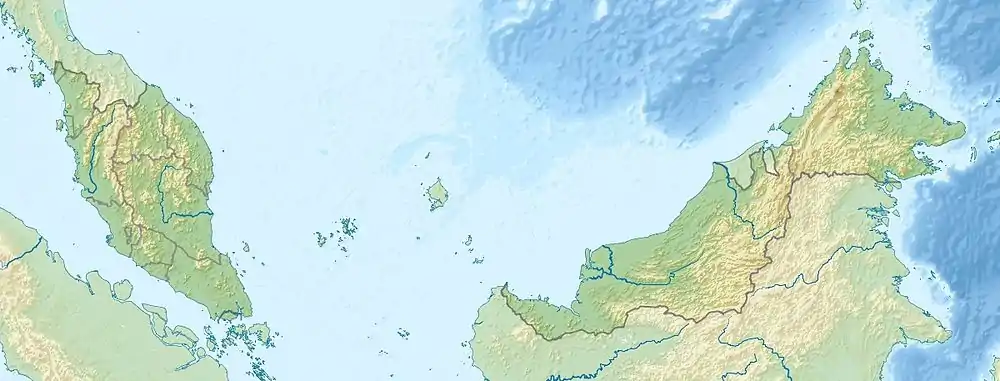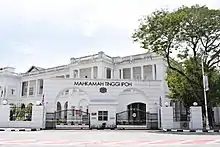1982 Bukit Merah radioactive pollution
The 1982 Bukit Merah radioactive pollution is a radioactive waste pollution incident in Bukit Merah of Kinta District in Central Perak, Malaysia. The outcome of the pollution case took several years to complete with no acknowledgement of responsibilities from companies involved despite the closure of factory in 1994 that become the source of pollution.[1][2]
 1982 Bukit Merah radioactive pollution (Malaysia) | |
| Date | 1982 |
|---|---|
| Location | Bukit Merah, Perak, Malaysia |
| Coordinates | 4.546337°N 101.046873°E |
| Cause | Illegal disposal of radioactive waste to nearby town |
| Outcome | Asia Rare Earth Sdn Bhd (ARE) ceased its operation following increasing pressure locally and internationally with its factory being closed in 1994[1] |
| Deaths | Seven dead as a result of the pollution[2] |
| Non-fatal injuries | Birth defects and eight leukemia cases within five years in a community of 11,000[2] |
Background
A rare earth extracting company named Asia Rare Earth Sdn Bhd (ARE) was established in 1979 for yttrium extraction in Bukit Merah, Perak with the biggest shareholders for the company was the Mitsubishi Chemical Industries Ltd and Beh Minerals (both with 35% share) together with Tabung Haji and other Bumiputera businessmen owning lesser shares.[1][4] In 1982, the newly established company began to extracting yttrium from a mineral named monazite which contains different earth elements with radioactive including thorium and uranium. Since the company of ARE starting its operation, residents from a nearby town of Papan began to complaining unpleasant odour and smoke from the factory where they also had breathing difficulty as a result of the pollution. The residents later discovering in 1984 that the extracting company of ARE had built a waste channel to a disposal site near their town under the consent of the state government of Perak.[1]
Affected residents reaction towards the pollution
Upon knowing that the state government were in part involved in the activities, around 6,700 residents from the affected town of Papan and several others from nearby towns signed a petition that was subsequently sent to various government departments, including the Perak Menteri Besar and Malaysian Prime Minister offices, the Health Ministry and the Science, Technology and Environment Ministry while 3,000 residents including women and children participated in a peaceful assembly and another 200 blocked the road to the waste disposal site.[1]
Government responses
Nonetheless, the Malaysian Prime Minister at the time Mahathir Mohamad responded that the government had taken every precaution to ensure safety with the construction of the radioactive disposal site will be continued regardless of the protest with the Science, Technology and Environment Minister Stephen Yong Kuet Tze also denying any potential health hazards and stressing that the disposal site was safe as it was built under strict regulations, challenging the affected residents to back up their claims that the disposal site was indeed hazardous.[1] Despite the conclusion gathered from international experts, the government decided to proceed with the activities where the residents later continue their protests and performed a one-day hunger strike against the government decision. In 1985, Malaysian Deputy Prime Minister Musa Hitam showed his concern by visiting the site and subsequent cabinet meeting lead by the latter was held to move the disposal site to the Kledang Range, about 5 kilometres from the town area. Following the third revelation, the federal government through a minister from the Prime Minister's Office Kasitah Gaddam said the levels were still safe despite it being more than the limit with an excuse reason such as the number of sites were very small.[1]
Investigation and subsequent events
To prove that their claims was indeed true, the residents of Papan aided by residents from the nearby towns of Bukit Merah, Lahat, Menglembu and Taman Badri Shah formed the Bukit Merah Acting Committee.[1] The committee was visited by a local environmentalist group Sahabat Alam Malaysia (SAM) who measured the radiation levels at the open space and pool near the factory with a conclusion that the radiation on these places to be 88 times higher than the upper limit allowed by the International Commission on Radiological Protection (ICRP) with a memorandum was then submitted to the country Prime Minister.[1] With the increasing pressure, the Malaysian government then invited a team comprising members from International Atomic Energy Agency (IAEA) to visit the factory where three international nuclear experts from Japan, the United Kingdom, and the United States also found that the waste channel are totally not safe for the public.[1] Another expert from Japan were called thereafter to gather further evidence where he found that the radiation levels were 800 times the permitted maximum level.[5]
Court case

In 1985, eight of the town residents including one who is a cancer victim bring the case to the High Court with 1,500 people from the affected area were present to hear the verdict.[6] A temporarily stop work order was subsequently issued by the court until a satisfying safety measures being taken by the ARE company.[1] However, in just a month after the order, the company invited an American atomic specialist to prove the factory are safe to continue their operation. This was countered with the second visit by the expert from Japan along with the revelation from two former workers of the company where they revealed further several thorium dumping sites in Bukit Merah to Atomic Energy Licensing Board (AELB) with the Japanese expert discovered that the radiation levels at these places were significantly over the ICRP's maximum safety limit. The company then ordered by the court to stop all operation but the AELB continue to issue a license to the latter to continue their operation in 1987.[1]
With the company refusal to stop despite court order, the affected residents began to sue the company which evolve into a court battle that took 32 months and in July 1992, the residents won their case against the company with the court ordered them to close their factory within 14 days. Even with the second court order, the company continue to filed an appeal case to the Federal Court where the Ipoh High Court's decision was suspended under two reasons such as the ARE's experts were more trustworthy and asking the residents to ask the Malaysian atomic board by themselves to withdraw the company license as the board had the power to do so under the Atomic Energy Licensing Act.[1] Without wasting further time in a long case that affecting their livelihood, several of the affected residents travel to Japan to meet up with the highest authority of Mitsubishi Chemical, one of the company major shareholders and explaining their dire situation which also being heard by Japanese environmentalists.[2] With Mitsubishi's intervention and further international pressure, the company finally stopped their operations despite having won the court battle locally.[1] Mitsubishi Chemical reached an out-of-court settlement with the affected residents by agreeing to donate $164,000 to the community's schools while denying any responsibility for the related illnesses from pollution caused by the ARE related works.[2]
See also
Further reading
- Sze Ming (7 March 2012). "Photo Essay: Lessons from radioactive poisoning in Bukit Merah (1985)". LoyarBurok. Retrieved 26 August 2019.
- Badd Hakim (7 June 2019). "30 Years Ago, a Huge Radioactive Incident Happened in Perak. And They're Still Cleaning It Up…". cilisos.my. Retrieved 26 August 2019.
References
- "Chronology of events in the Bukit Merah Asian Rare Earth development". Penang Consumer Association. 11 May 2011. Retrieved 26 August 2019.
- Keith Bradsher (8 March 2011). "Mitsubishi Quietly Cleans Up Its Former Refinery". The New York Times. Retrieved 26 August 2019.
- Consumers Association of Penang (1993). Wasted lives: radioactive poisoning in Bukit Merah. Consumers' Association of Penang. ISBN 978-967-9950-80-9.
- Joshua Karliner (1997). The Corporate Planet: Ecology and Politics in the Age of Globalization. University of California Press. p. 120. ISBN 978-0-87156-434-4.
- Vinod Raina; Aditi Chowdhury; Sumit Chowdhury (1999). The dispossessed: victims of development in Asia. Arena Press. p. 268.
- Andrew Rowell (25 September 2017). Green Backlash: Global Subversion of the Environment Movement. Taylor & Francis. p. 265. ISBN 978-1-351-56499-1.